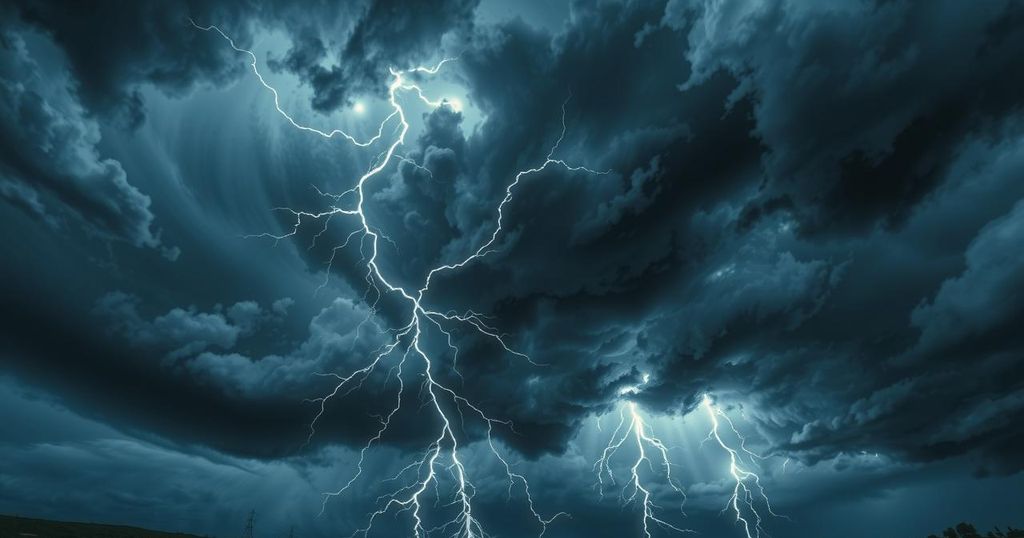Unusual Weather Patterns Blamed for Deadly Thunderstorms in Northern India
Severe thunderstorms in northern India on Wednesday resulted in at least 59 fatalities, attributed to unusual weather patterns and persistent winter disturbances affecting the monsoon. Meteorologists noted that the storms stem from a complex atmospheric cocktail, intensified by changing global conditions like Arctic warming. Experts continue to warn about the implications for India’s weather systems and agriculture due to these changes.
On Wednesday, at least 59 lives were lost in northern India when powerful thunderstorms swept through the region. This inclement weather, which struck late in the day, was linked to a series of unusual climate patterns and persistent winter disturbances that continue to affect the Indian monsoon. The trends observed indicate a worrying interplay of various atmospheric conditions resulting from global weather changes.
Meteorologists have attributed the storm to a complex blend of various factors, including several cyclonic circulations, warm moisture presence from adjacent seas, and elevated daytime temperatures. This unusual weather event was further intensified by the persistence of Western Disturbances—a winter weather system that typically dissipates by summer. According to M. Rajeevan, former secretary of the Ministry of Earth Sciences, the characteristic behavior of these disturbances has shifted, continuing to impact the summer season.
Rajeevan made it clear that a change in the pattern of Western Disturbances is becoming increasingly evident. “You expect western disturbances to move north of the Indian region in April, May, June months. In some years we are seeing that their impact is continuing in summer which is not good for the monsoon,” he noted. This is a concerning situation given that studies show reduced Arctic ice levels could ultimately influence monsoon extremes in India.
Their assessment runs parallel to weather phenomena observed thousands of kilometers away in the Arctic. In fact, both Iceland and western Greenland experienced unusually high temperatures recently, with the former nearing a record high of 27°C. All this, experts suggest, is being driven by Arctic warming that forces cold fronts to move southward—another factor pushing Western Disturbances into India.
Compounding these shifts, the storm that occurred on Wednesday was also driven by a rare confluence of atmospheric conditions. Rajeevan elaborated, stating that the presence of cyclonic circulation combined with a trough affected the northern region significantly. The ensuing instability resulted in thunderstorms and heavy rainfall, described metaphorically as “bubbles” of moisture bringing conditions ripe for severe weather. Although such occurrences are uncommon, they are not impossible, prompting scientists to monitor their implications for the monsoon season.
The Indian Meteorological Department (IMD) clarified that there was no active Western Disturbance over northwest India at the time of the storm. However, some experts suggested that the cyclonic circulations contributing to the thunderstorms were indeed a product of mild Western Disturbances. Mahesh Palawat from Skymet remarked on the presence of a cyclonic circulation over southern Punjab. This situation is likely to produce moderate dust storms and thunderstorms across the northwest region until late May.
The hardest-hit area was Uttar Pradesh, especially western parts of the state. The fatalities were primarily due to lightning strikes and structural collapses. For example, a 65-year-old man died in Saharanpur, while a young girl lost her life in Sonbhadra due to lightning. Additionally, some individuals were crushed by falling walls or trees—tragedies that illustrate the serious hazards linked to such extreme weather.
In Delhi, the storm showcased its might with wind speeds that hit 79 km/hr. These conditions led to abrupt temperature changes, with significant drops from 37°C to 23°C in just one hour. Rainfall measurements included 13.5mm recorded in Mayur Vihar, all within moments. This inclement weather halted flights at Indira Gandhi International Airport and caused disturbances in metro services, indicating the severity of the storm’s impact.
Further complicating the weather dynamic, a low-pressure area over the Arabian Sea is expected to intensify into a depression by Friday, which may result in an earlier start to the monsoon in Kerala. However, Rajeevan cautioned that the ongoing presence of Western Disturbances could hinder the effective progression of the monsoon season—a pattern that could spell trouble for agricultural activities in the region.
The deadly storm this week is a sobering reminder of how interconnected global weather patterns are. As climate change continues to alter atmospheric behavior, countries like India may face increasingly severe weather events that could disrupt agriculture, infrastructure, and more, ultimately affecting the livelihoods of millions.
In summary, the tragic thunderstorms in northern India, which claimed at least 59 lives, are attributed to a convergence of unusual atmospheric conditions, including persistent Western Disturbances. Meteorologists warn that ongoing climate disruptions, driven by Arctic warming, could further complicate the monsoon’s arrival and intensity. Such extreme weather patterns not only pose immediate risks but also signify potentially long-lasting changes in rain patterns, posing risks to agriculture and infrastructure.
Original Source: www.hindustantimes.com




Post Comment